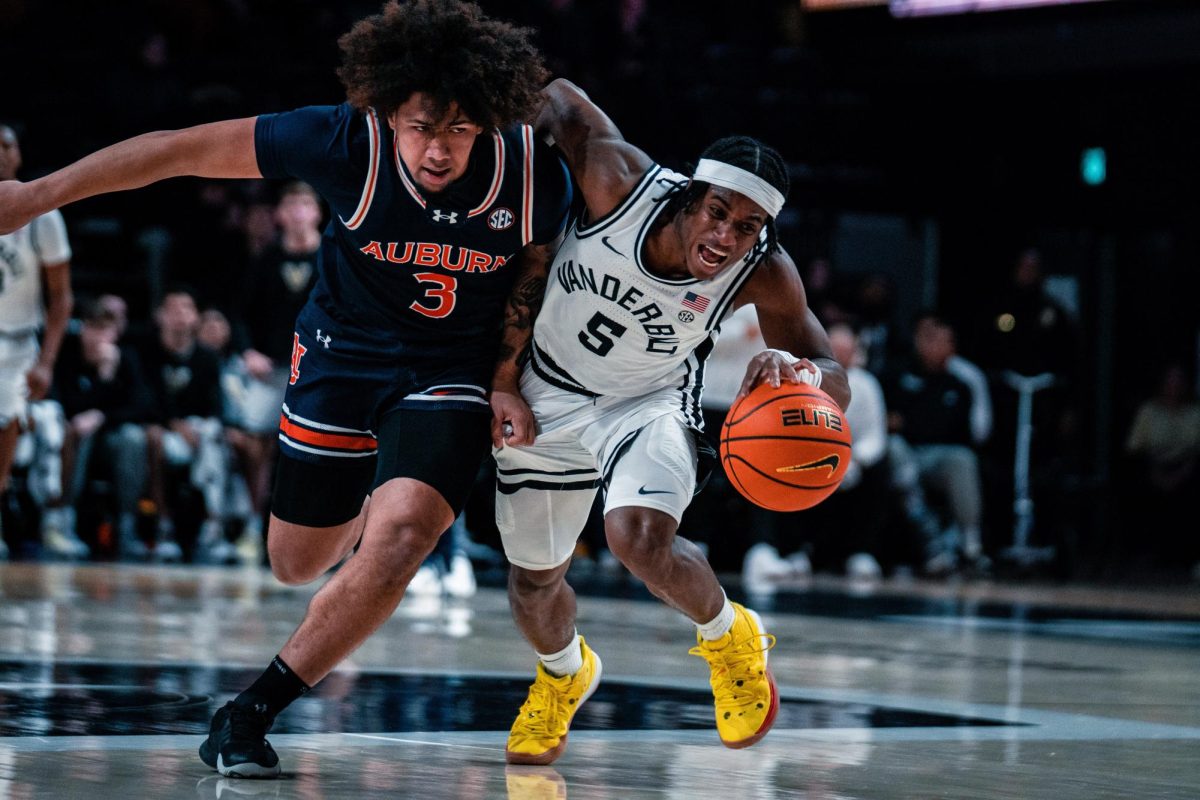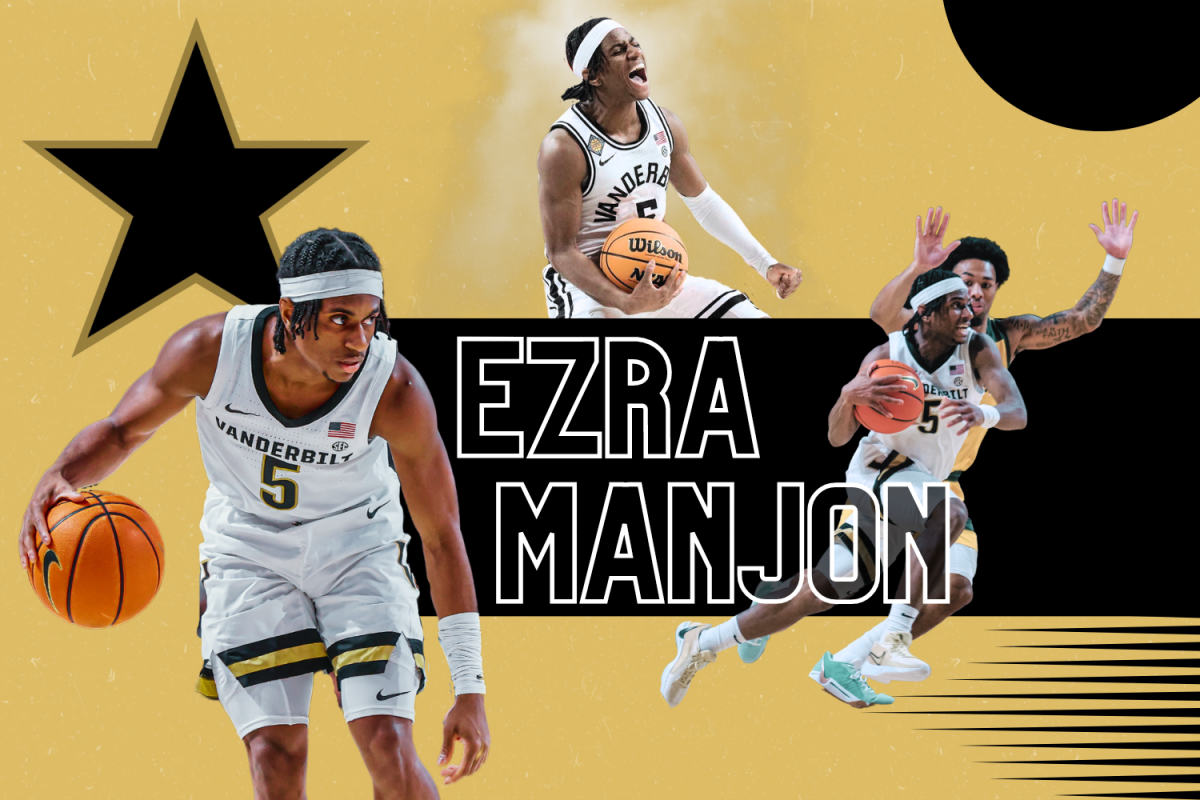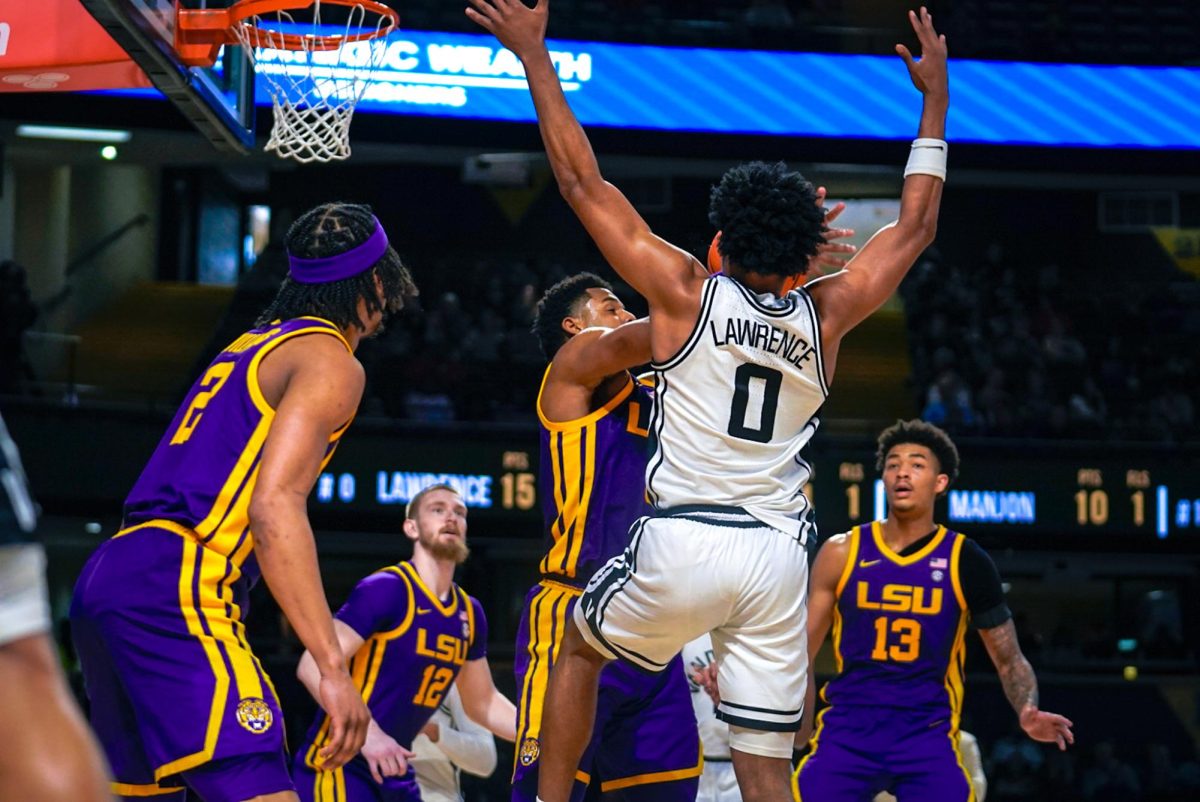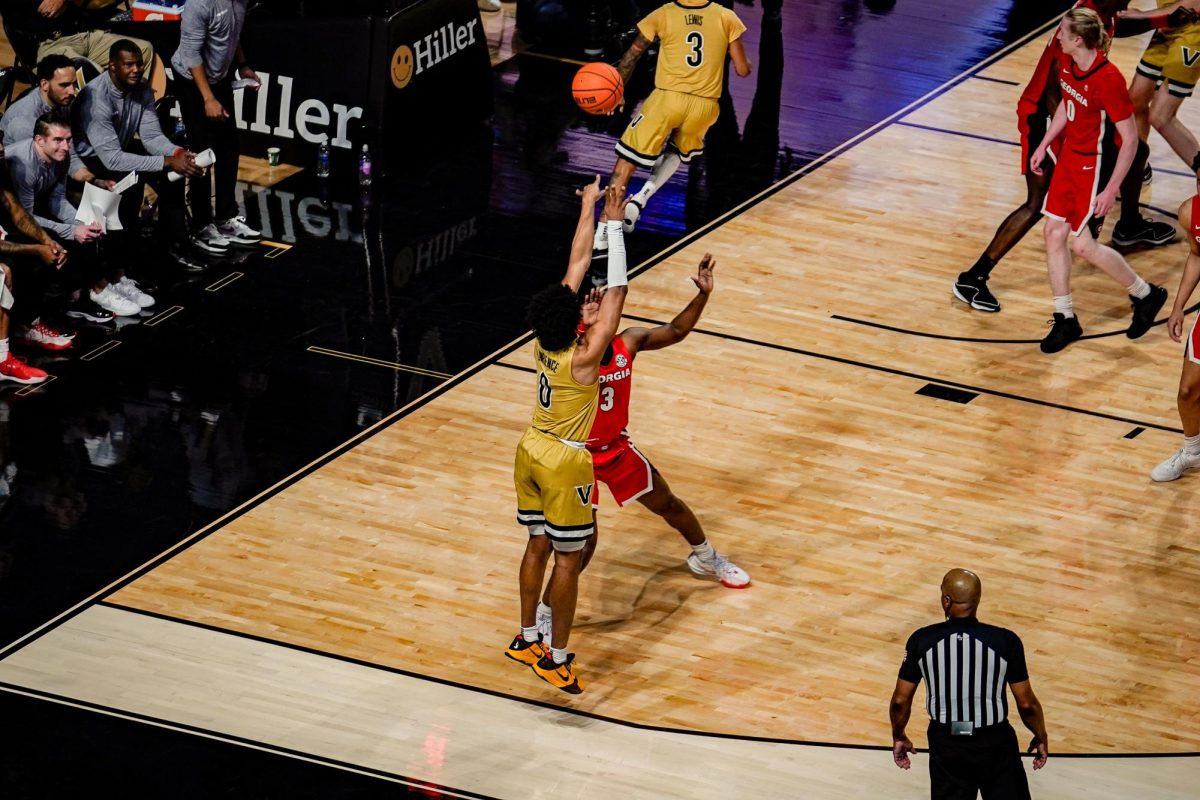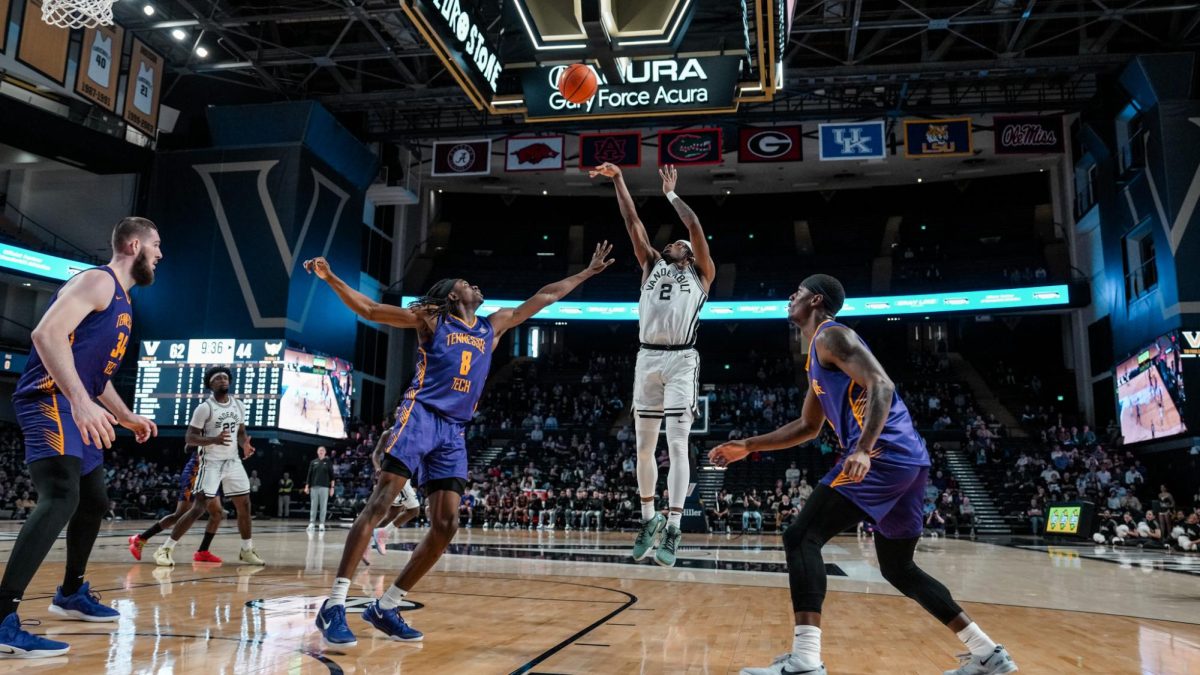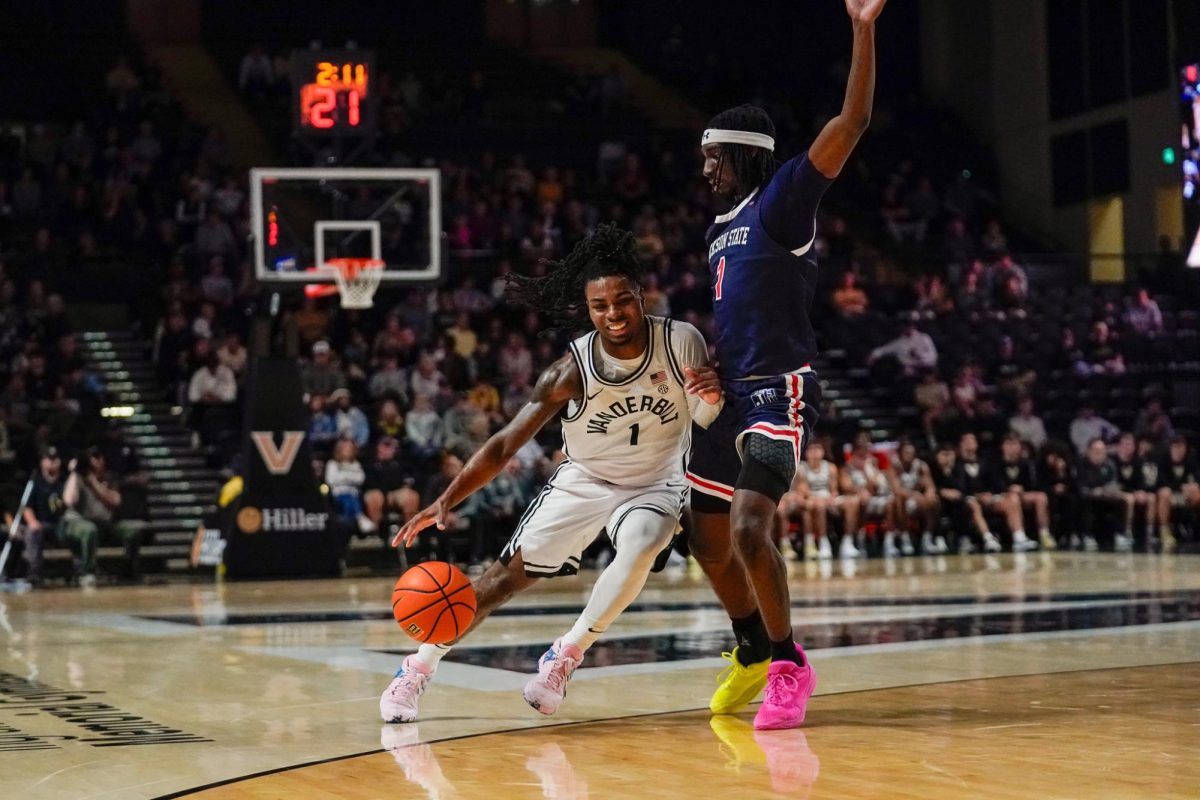Following a recent blowout against the No. 8 Auburn Tigers and a deflating loss to Mississippi State, Vanderbilt Men’s Basketball is officially 5-13. The Commodores remain at the bottom of the SEC and continue to be one of the teams struggling the most in the high-majors, putting them at No. 235 in the NET rankings. Between lackluster play, questionable coaching and miserable results, this season is spiraling out of control.
Amidst the mounting issues, there have been minuscule spots of positivity. Senior guard Ezra Manjon has been essential in keeping the team afloat, being the leader everyone hoped for him to be on the court. Averaging 15.2 points, 3.1 rebounds and 3.3 assists on a 26% USG rate, Manjon is the heartbeat of Vanderbilt. Since returning from injury, Tyrin Lawrence has finally strung together a few decent performances, but not to the level of his play last season. Not to mention that freshman Jason Rivera-Torres is shaping up to be a possible star in Vanderbilt’s future, even though he has been utilized as a spark off the bench, only getting his first career start against Mississippi State.
With that being said, it’s impossible to overlook the glaring issues this team has, and those concerns have translated to rough performances on the hardwood. From top to bottom, this roster has struggled in every facet of play. A lot of these concurrent issues spring from the offense, which has lacked consistency, organization, stability and a general identity. Offensively, the Commodores rank 337th in the nation in field goal percentage, 314th in assist-to-turnover ratio and 317th in scoring. Sticking to this matter, let’s look at why the Vanderbilt offense has problems on the court.
Too broke to buy a bucket
Shooting has been arguably the most prominent issue with the Commodores. Game after game, Vanderbilt posts up immensely frustrating shooting nights, especially from behind the arc. The Commodores are an undersized team lacking a core post presence, forcing the unit to attempt to shoot the lights out at any given chance. The issue is that this team doesn’t find themselves with many open threes because of how predictable they’ve become. Even when they do have open looks, they fail to convert them. At the moment, Vanderbilt attempts nearly 24 three-pointers a game and the team’s percentage on these shots is a detrimental 28.83%, 335th in all of Division I basketball.
The decline is evident, particularly amongst players who played last season. In 2022-23, Lawrence shot 36% from three, but at this point in the season he’s shooting 28%. Paul Lewis made 39.5% of his shots from beyond the arc a season ago. This year, he’s shooting an abysmal 18.6%. The only shooter who has been somewhat consistent is transfer Tasos Kamateros, although he’s shooting at a lower mark in attempts and percentage than his last season at South Dakota. Even then, Kamateros has become a one-dimensional stretch shooter, making it obvious to defenses that he’s a threat exclusively from deep.
It’s hard to direct an offense that is reliant on the three ball and devoid of a paint presence. Because of the lack of size and interior scoring, pick and rolls or dribble-drives are immediately shut down by defenses, forcing kick outs to be a reliable, yet obvious, opportunity to score. Still, Vanderbilt frequently struggles to create anything off the dribble or during a play, constraining the team to bad three-point attempts with minimal time on the shot clock. At the same time, there isn’t a true playmaking option to generate an open three point shot on their own in one-on-one situations. To put it simply, the talent isn’t there. In fact, the talent that was here last season, like Myles Stute and Jordan Wright, have shown to be consistent scorers and shooters for their new teams. Vanderbilt doesn’t have anyone to dominate within a desired three-point centered offense. Lawrence would be that expected off the dribble shot creator, but nothing is going his way. Manjon is undoubtedly the best slasher on the team, but during his entire college career his deep ball has been inconsistent. Kamateros would be the ideal catch and shoot big man, but the shots just aren’t falling. The shooting efforts are an amalgamation of poor shot selection, ineffective plays and blatant missed open looks.
Incoherent scrambling
What builds into these shooting problems and other various offensive issues has not simply been an overall slump or a disparity in scoring output, but what seems to be a lack of cohesiveness. In the Mississippi State game, Vanderbilt trotted out its 12th different starting lineup this year, while also being one of the youngest teams in the country. Inexperience, injuries and a continuous shuffling of the rotation by Jerry Stackhouse has added to the problem by not allowing for any true chemistry to develop on the floor. Without real cohesion on offense, it makes Vanderbilt look alarmingly lost on the court. This disorienting play comes in the form of taking a long amount of time to run plays out of sets or just not having enough activity across the hardwood to make up for their weaknesses. Yes, it has been said countless times that this team isn’t the biggest or that this team isn’t the best in isolation, so why can’t there be more aggressive cuts and meaningful motions to facilitate better opportunities? When looking at Vanderbilt Men’s Basketball’s counterpart led by Shea Ralph, movement and a never-ending state of activity is what opens the door for their offense. This team desperately needs to do the same. Stackhouse instead opts to perpetually change the units that take the floor and cause a perennial shift in how minutes are distributed. Against Mississippi State, twelve different Commodores took the floor, with players like Kamateros and Lewis getting the same amount of minutes as walk-on Graham Calton.
The Commodores also currently rank 165th in pace, a stat that measures the number of possessions a team has over 40 minutes. To make matters worse, Vanderbilt has only led for about 4 minutes out of the 200 minutes it has spent on the court in its five conference games so far. One would think that for a team frequently playing from behind, every possession would matter more and would simultaneously cause the team to ramp up the pace to get more possessions to carve into a lead. However, any opportunity to even attempt such a feat is exceedingly limited by the absence of continuity in the Commodores’ offense. The murky, unestablished identity makes the five players in the game seem less like a unit and more like just five individuals scrambling to get anything going. There isn’t any real chemistry, ultimately leading to poor decision-making and costly mistakes. As a candle on the cake of complications, Vanderbilt is 120th in offensive rating, a hallmark sign of an inability to function well.
Run out the gym
Sometimes extreme effort goes a long way. Losses will happen in college basketball, and a trademark of quality teams is the ability to fight until the end to make games close. Vanderbilt had some moments that showed that positive feistiness, such as against No. 19 Memphis and Alabama. However, for the past three games, Vanderbilt has lost by double-digits, showing a heightened sense of onset defeat and a feeling that the Commodores just can’t keep up. In every contest, Vanderbilt looks less polished and slow in comparison to their opposition, making an already inefficient offense bleed into lackadaisical efforts on the other end of the court.
A slight positive is that Vanderbilt keeps its turnover margin relatively even, meaning that the Commodores are forcing as many turnovers as they’re giving up. So in a sense, Vanderbilt isn’t giving up that many fastbreak points off turnovers on the stat sheet. But, the problem lies in the context of the games, where it appears that Vanderbilt is always vulnerable in transition. To put it simply, the Commodores get run off the floor.
Repeatedly, whether it be off of a missed shot or a turnover, the frustrations of the offense turn into mind boggling defensive miscues, giving opposing teams easy chances to score. Missed pickups, failed rotations and late recognition by individual players gives a fast-paced offense unbridled access to Vanderbilt’s defensive weak points. This develops another dilemma for the Commodores: falling behind.
Being outpaced and giving up effortless buckets snowballs into these massive runs where opposing teams churn out a lead that Vanderbilt can’t recover from. Stretches like these have occurred all across Vanderbilt’s conference play. For example, against No. 8 Auburn, what was originally a 16-14 Vanderbilt lead turned into a 20-2 Tigers’ run in just over 6 minutes. The Commodores would never lead or even come close to tying that margin for the rest of the game. Against Ole Miss, where a second half surge by Vanderbilt cut a 14-point Rebels lead to three, Vanderbilt would give up a 14-4 run, ultimately losing by 13. Mixed in these games are compilations of runs where the Commodores can’t seem to score and end up pinned on the ropes defensively.
Comprehensively, Vanderbilt has been outplayed, outcoached and outmatched in recent conference outings. A plethora of issues plague the Commodores, and with a schedule that only grows more difficult going forward, this season could take a more disastrous turn if changes aren’t made. Nevertheless, through 18 games, the Vanderbilt Commodores possess a lot more questions than answers.

